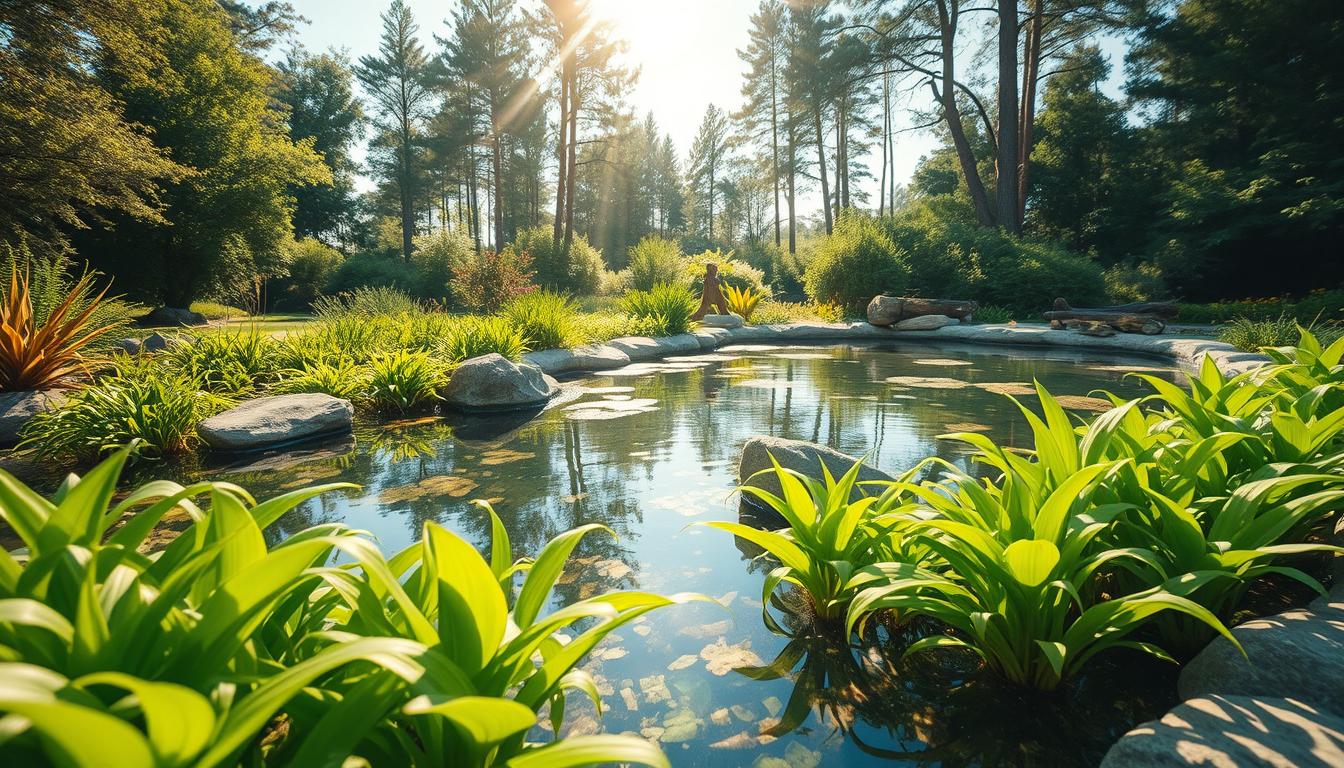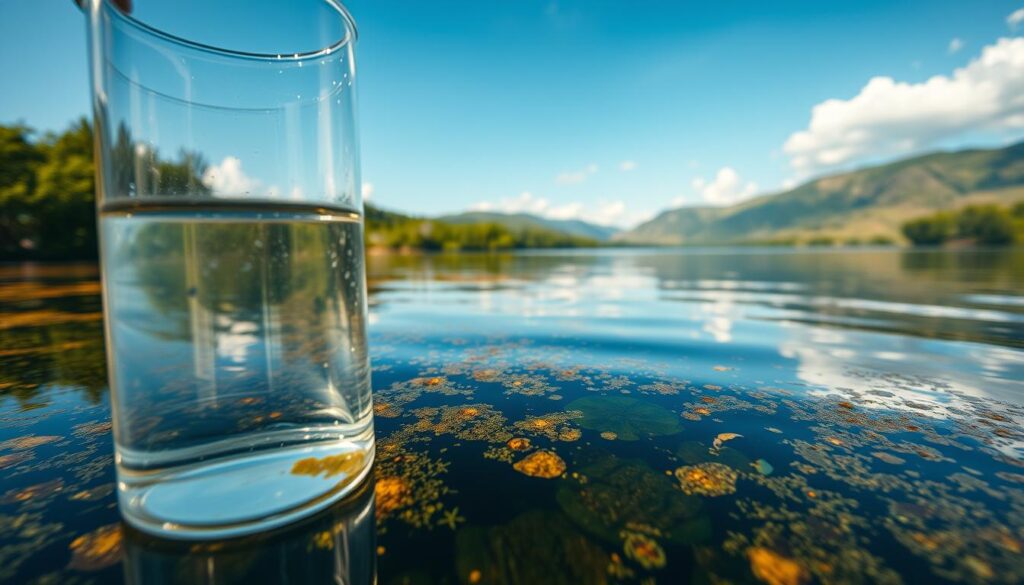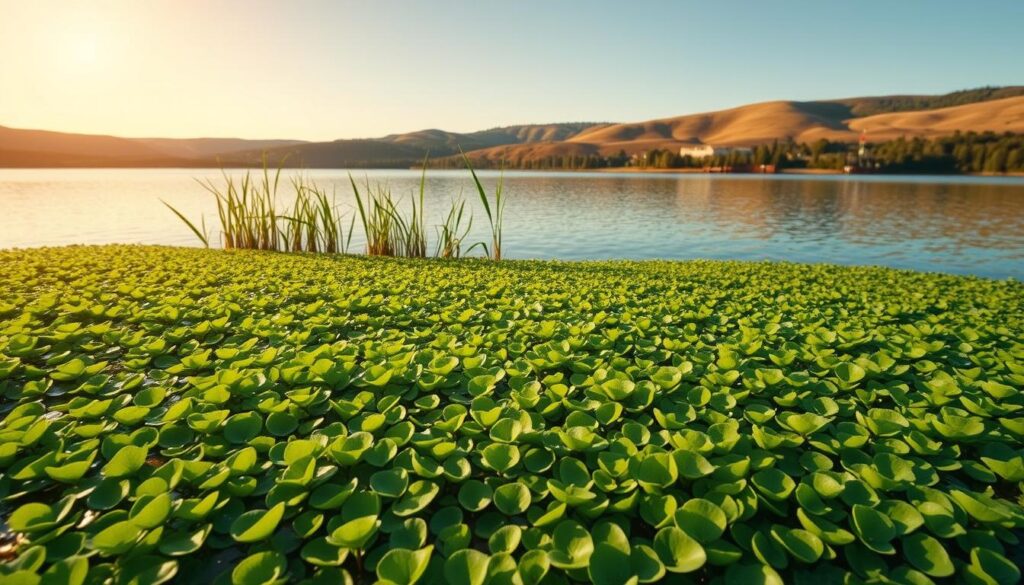
Our service-first approach focuses on natural methods that protect water and aquatic life before we use targeted treatments.
Filamentous algae can feed invertebrates and fish in small amounts, but thick mats show excess nutrients and threaten oxygen balance. Photosynthesis adds oxygen by day, yet growth consumes oxygen all the time. At night or during cloudy stretches, tanks and ponds can lose oxygen fast and harm fish.
We start by assessing current conditions, risks to fish, and nutrient sources. Then we sequence a plan: aeration to stabilize oxygen, pond dye to limit light to the bottom, and beneficial bacteria to transform ammonia and nitrate into harmless nitrogen gas.
If rapid relief is needed, our experts select the right product and apply it based on growth form—granular for bottom mats, liquid for floating blooms. This layered approach supports long-term water quality and prevents repeat outbreaks.
Key Takeaways
- Start with a service-first assessment to protect aquatic life and set clear goals.
- Stabilize oxygen with aeration to reduce fish kill risk.
- Limit sunlight and nutrients using pond dye and beneficial bacteria.
- Match any product use to the specific growth form for safe, fast relief.
- Combine prevention and targeted treatment for lasting water quality.
Assessing Water Quality and Identifying Algae Before Treatment
Begin with a visibility check. If you can see less than 18 inches into a pond or lake, the system is likely imbalanced and at risk for rapid blooms and oxygen swings.
Planktonic “green water” appears as pea-soup coloration in the water column. These suspended diatoms and single-celled forms can be green, yellow, blue-green, or brown. Heavy planktonic growth cuts light and can cause night-time fish stress and even kills after cloudy stretches.
Filamentous growth forms thin mats that float on the surface or lie as sheets on the bottom. Texture and placement matter: surface rafts respond differently than benthic sheets, and treatment choice depends on whether the target is floating or bottom material.
Macroalgae like chara and nitella lack true roots. Chara is gritty and skunky and favors hard water. Nitella is more delicate, odorless, and common in softer, acidic conditions.
- Record visibility, odors, and any clogging to prioritize action.
- Sample nutrient levels to confirm drivers of growth and set baselines.
- Document whether mats are on the surface or bottom to guide application method.

Natural solutions for algae management and prevention
A layered plan of aeration, light limitation, and biology delivers lasting improvements to pond health.
Pond aeration to stabilize dissolved oxygen
Deploy aeration around the clock to steady dissolved oxygen and reduce stress on fish. Continuous mixing cuts the risk of nighttime drops that often follow heavy blooms.
Consistent use of pond dye to limit sunlight
Use pond dye to shade the water column and prevent new growth on the bottom and along shallow margins. Regular dosing keeps sunlight from fueling surface and benthic growth.

Beneficial bacteria and nutrient source control
Inoculate with beneficial bacteria that digest ammonia, nitrate, and nitrite and help free nitrogen escape as gas. This lowers nitrogen and phosphorus levels and reduces future blooms.
Pair in-water biology with source fixes on land: cut fertilizer runoff, add shoreline buffers, and change irrigation to limit nutrient inputs.
Ultrasonic treatment and sequencing with targeted products
Consider ultrasonic systems to reduce light access and make colonies sink without toxins. For filamentous growth that starts on the bottom, apply granular products in place, then follow with light limitation and bacteria to curb regrowth.
- Build a seasonal maintenance plan for dye, aeration runtime, and bacteria dosing.
- Track clarity and oxygen in the column to verify effectiveness and refine the plan.
Targeted algae control: proven treatments and service programs
Tackling stubborn growth requires matching application method and product chemistry to where the material lives in the pond.
Rapid knockdown: For urgent situations, use a broad-spectrum option such as Captain XTR. Its chelating agent and surfactants help penetrate dense mats and extend contact time in the water column.
Bottom-targeting: Komeen Crystal delivers chelated copper to the bottom and is effective against benthic species like pithophora, chara, and nitella. Start granular for contact, then follow with liquid as mats rise to the surface.
Sensitive sites: Choose non-copper alternatives when needed. PAK 27 is OMRI listed and NSF certified for drinking water, making it suitable around trout, koi, and other sensitive fish.
Break the cycle: SeClear and SeClear G combine algal knockdown with phosphorus removal to lower future pressure. Pair treatments with nutrient management and a written maintenance plan.
- Monitor visibility and oxygen, treat early, and adjust dose by lake size and use.
- Provide scheduled maintenance and stakeholder coordination to protect water quality.
Conclusion
A successful program blends monitoring, prevention, and timely interventions for long-term pond health. Watch visibility and dissolved oxygen, dose pond dye, and keep aeration running to reduce the conditions that fuel blooms.
Use beneficial bacteria to lower nitrogen and phosphorus and start treatment at the bottom when filamentous material begins there. Move to liquid applications as mats rise.
Ultrasonics can limit light without toxins, while named products—Captain XTR, Komeen Crystal, PAK 27, and SeClear/SeClear G—offer tested options for different sites and uses.
Combine proactive management, scheduled maintenance, and clear product guidance to deliver a reliable algae control solution and protect water uses year-round.








